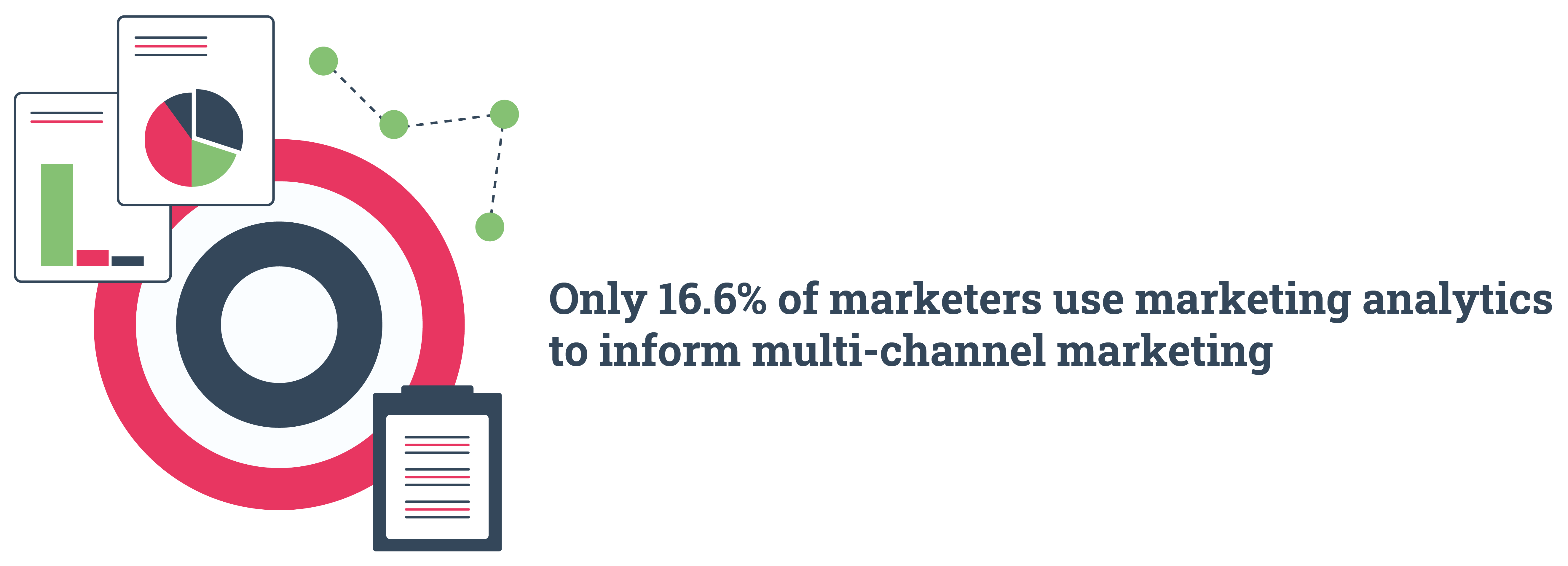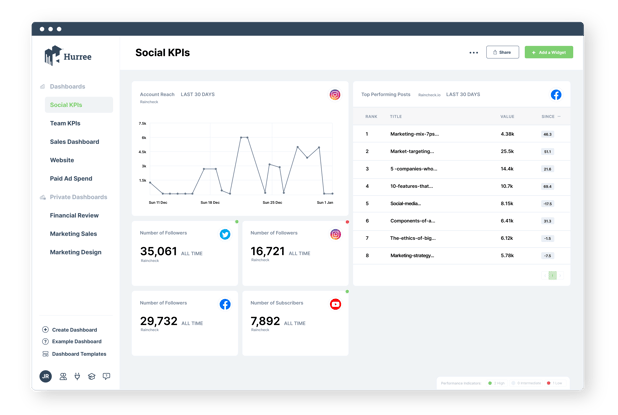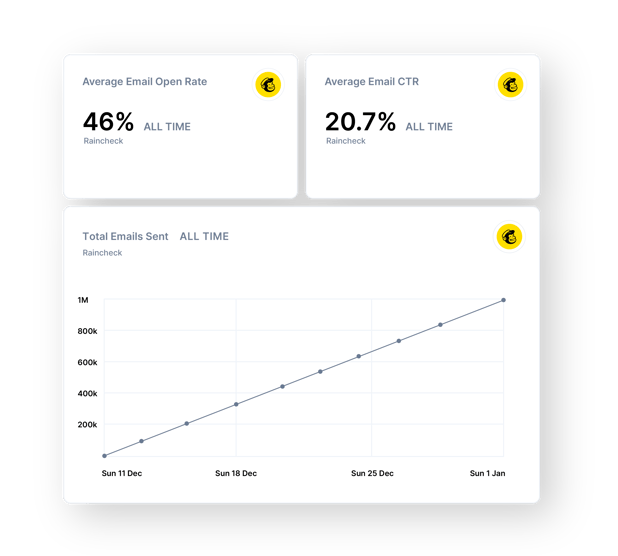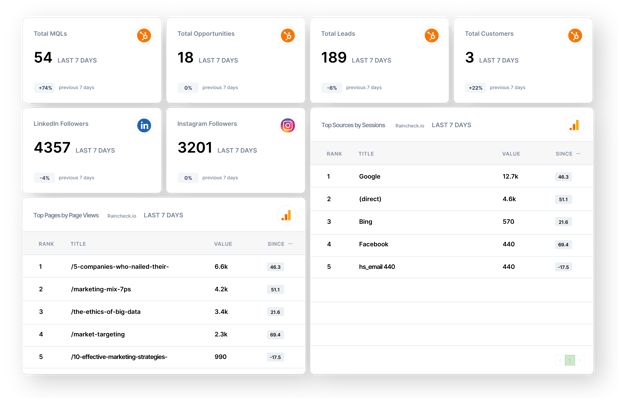What is a Marketing Dashboard? (With Examples)
Marketing technology, also known as martech, is a booming industry, worth more than $509 billion. Did you know that the average enterprise has up to 120 tools in its martech stack?
But having so many tools, all collecting and storing data in different ways, and using different metrics makes manually collating and mining this data almost impossible, especially for those operating omnichannel marketing strategies. Generating insights from such a large amount of data usually requires a dedicated analyst, which most marketing teams can’t afford.
In fact, 78% of marketers strongly or somewhat agree that it is difficult to assess how well brands perform across channels. But marketing dashboards offer a solution to the modern-day problem of data overload; cutting through the mountain and delivering only the metrics that matter to you.
What is a marketing dashboard?

Source: Oktopost
A marketing dashboard is a business intelligence tool used to bring all of your organisation’s most valuable marketing metrics together into a single display.
Marketing dashboards use visual information-sharing techniques, known as data visualisation, to provide at-a-glance overviews of performance. The visual aspects of this type of data - bar charts, graphs, colour keys, maps, etc. - make analysis and decision-making quick and efficient.
Marketing dashboards take the key metrics of a company, team, or even individual, and provide near real-time data to track performance and growth (the lag time of each tool will vary).
Dashboard metrics are commonly referred to as key performance indicators (KPIs) and include both high-level and granular areas of marketing performance. Metrics are understood and visualised within predetermined time frames such as weekly, monthly, quarterly, and yearly.
A well-designed marketing dashboard has several benefits:
- Aligning the entire company, department, or team around the most valuable metrics, with clearly visualised progress tracking and growth possibilities.
- Enabling at-a-glance understanding of performance across the department, saving management valuable time by replacing manual report creation.
- Facilitating a framework for the easy identification of successes and fast diagnosis of poor performance.
- Integrated visualisations make forecasting for future marketing strategies more efficient and accurate.

Source: Business2Community
Why are marketing dashboards important?
Put simply, marketing dashboards make tracking the metrics that matter easy and efficient, meaning businesses can make more informed decisions more quickly, stimulating growth. Marketing teams that set and track goals, something marketing dashboards are a key part of, are 376% more likely to report success.
Marketing dashboards are also an important piece of improving your customer experience. Customer experience encompasses all parts of your marketing and sales strategy and culminates in how your customer perceives your brand, how you treat them during their customer journey and how you work to build their loyalty. Being a data-driven marketing department ensures you are constantly optimising your output and interactions for the best possible customer experience.
So, how can a marketing dashboard help improve your customer experience?
- Use behavioural data to identify trends in user preferences and tailor future campaigns to cater to these.
- Use customer churn data to identify areas to improve loyalty and retention.
- Use SEO data to identify and create content that your customers are searching for.
- Use website analytics to identify points on your website when customers drop off and optimise these pages for a better user experience.
These are just a few examples of how data can be used to optimise your marketing output and improve your relationship with your customers. There are countless ways to use data to inform your marketing strategy and, with a marketing dashboard, you can do it all faster and avoid the human error that is inevitable with manual reporting.
How to create a marketing dashboard
The purpose and design of your marketing dashboards are determined by the goals you set for your business or team. Your dashboard exists to keep your team on track; steering them towards success and away from any potential problematic activities.
Let’s take a look at three types of marketing dashboards you can use to track your progress and goals:
1. KPIs dashboards: Used to monitor day-to-day operations, KPIs and metrics.
Hurree dashboard example
Marketing KPI dashboards act as the compass for marketing teams, steering them resolutely towards their goals. They are meant to be used regularly - weekly, or sometimes even daily - to measure progress towards your chosen goals and KPIs. Dashboards remove the need to manually check each platform and collate metrics across channels to report the results of these KPIs.
The simple, at-a-glance nature of dashboards means that any team member can quickly update themselves and make adjustments to their efforts to ensure they meet their goals.
Some examples of KPIs:
- Website traffic
- Leads generated
- Marketing qualified leads
- Sales qualified leads
- Conversion rate
- Revenue
- ROI (Return on Investment)
2. Channel-based dashboards: Forecast long-term strategies based on high-level overviews of channel performance
Understanding how a particular marketing tactic such as email marketing, performs overall allows you to confidently forecast future performance and informs the allocation of time and budgets.
Many email tools give granular reports that can be overwhelming and difficult to distil into high-level insight. With a strategic email marketing dashboard, you can focus on only the most important metrics that you need to make forecasting decisions. For example, if your team had set a goal of increasing email open rate across all campaigns by 10% over the last quarter, you could use your strategic dashboard to quickly visualise whether this goal had been met, exceeded or missed, and translate those results into revenue. All without leaving the dashboard or opening a calculator.
Some examples of channel-based dashboards:
- Email marketing metrics
- Facebook metrics
- Display advertising metrics
- Push notification metrics
3. Multi-channel comparison dashboards: Explore large data sets from multiple channels to identify trends and predict outcomes
Seeing all of your analytics from one place, across multiple channels and tools provides a comprehensive view of your performance. Not only do you save time on reporting by removing the need to move between tabs and format reports, but having all of your conversion metrics in one place enables you to quickly optimise underperforming channels or reallocate money to high-performing campaigns.
There are multiple ways in which you can create cross-channel marketing dashboards to monitor tactic performance. For example, you can create a dashboard that monitors all of your digital advertising tools, reporting on the key metrics for ad campaigns. Within one dashboard you could compare: impressions, CTR, conversion rate and CPC for Facebook Ads, Google Ads, LinkedIn Ads and TikTok Ads. Having all of this information in one place would reduce the time it takes to compare platforms and reallocate budgets to those that are performing best.
Examples may include:
- SEO dashboard
- Content marketing dashboard
- Ecommerce dashboard
- Digital advertising dashboard
Best practice for marketing dashboard design:
- Clearly define the goal of your dashboard and which metrics will be most important to that goal.
- Don’t over-clutter your dashboard, remember marketing dashboards are meant to give at-a-glance insight.
- Use various different visualisations to help metrics stand out from one another.
- Integrate all of your marketing tools to avoid data silos.
Summing up
Data-driven marketing is essential in today’s competitive marketing environments where customer experience is a key differentiator. GlobalDMA found that 49% of marketers use data to enhance customer experience.
Knowing your target audience inside out is vital, without this knowledge you’ll be left making assumptions about your audience that might be way off base, or even worse, offensive. By using the marketing data that is being generated by your martech tools in a smarter way, with dashboards, you can gain insights about your audience that you may never have discovered on your own.
Marketing dashboards cut through the clutter of marketing data and pull out only the information that you have defined to be important. These dashboards simplify data so that you can make faster, more accurate decisions and engaging visualisations take the fear out of working with complex data sets, empowering every member of your team to embrace data-driven practice.
Get started on your free trial Hurree today and discover how to truly harness the power of analytics and transform your company reporting using cross-platform dashboards. If you have any questions then feel free to reach out to contact@hurree.co, we'd be happy to answer them!
Share this
You May Also Like
These Related Stories

What Should You Include in a Marketing Dashboard?

12 KPIs to Include in your Sales Analytics Dashboard







